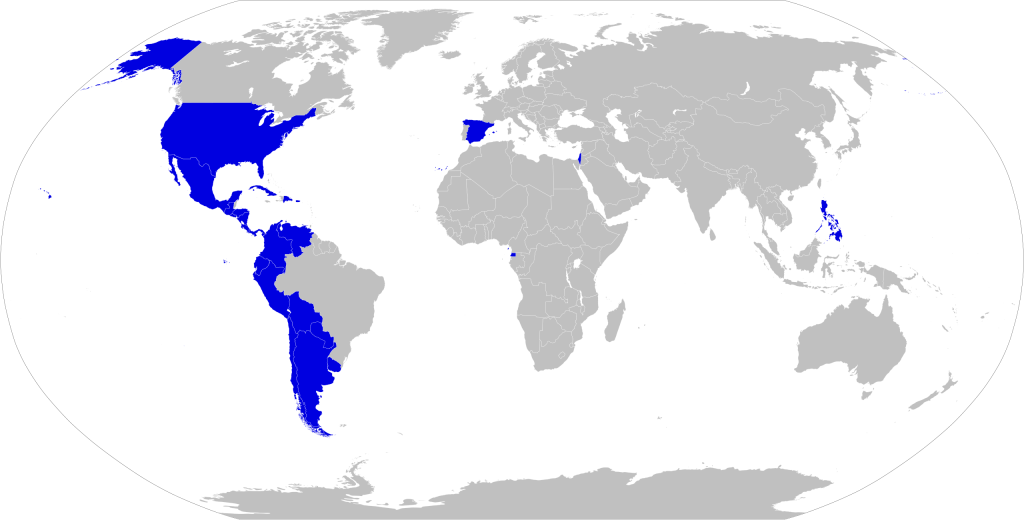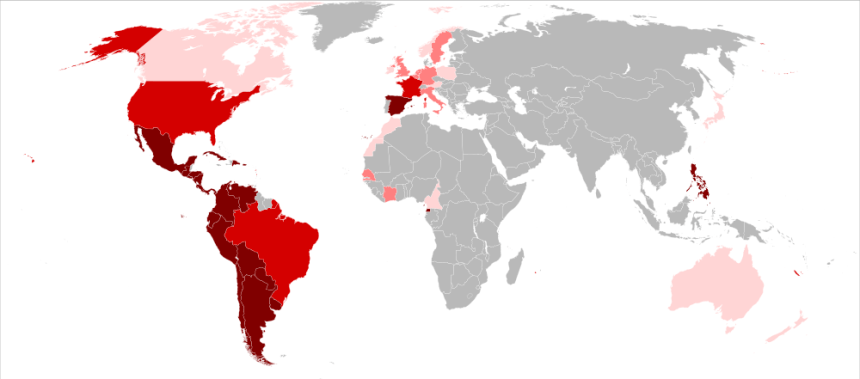Spanish (español or lengua española) is a Romance language with its roots in colloquial Latin, originating from the Iberian Peninsula of Europe. It has become a global language spoken by approximately 474.7 million native speakers, primarily in the Americas and Spain. Spanish is the official language in 20 countries, making it the second-most spoken native language worldwide, following Mandarin Chinese. It ranks as the fourth most spoken language, after English, Mandarin Chinese, and Hindustani (Hindi-Urdu). Additionally, it stands as the most widely spoken Romance language. Mexico holds the distinction of having the largest population of native Spanish speakers.
Spanish Language
| Language Family: | Romance language (Indo-European) |
| Native Speakers: | Approximately 486 million (as of 2023) |
| Official Language in: | 20 countries, including Spain, Mexico, Argentina, and more |
| Second Language Speakers: | Approximately 75 million |
| Internet Usage: | Third most used language on the Internet after English and Chinese |
| Official Language in International Organizations: | United Nations, European Union, African Union, and more |
Spanish (español or lengua española) is a Romance language that evolved from colloquial Latin spoken on the Iberian Peninsula of Europe. It is the second most spoken native language globally and the fourth most spoken language overall. Spanish is widely used in various regions, including the Americas, Spain, and Equatorial Guinea. It has a rich history and influences from Latin and other languages.
In some areas of the Spanish-speaking world, Spanish is known as castellano, contrasting it with other languages spoken in Spain such as Galician, Basque, and Catalan. Both terms, español and castellano, are considered synonymous and valid.
The term castellano is related to Castile (Castilla), the kingdom where the language was originally spoken. Spanish has influences from Arabic and other Romance languages, making it a unique and vibrant language.
Spanish has a long history and influence in the Americas, with many countries in Latin America adopting it as their official language. It also has a significant presence in the United States, where it is spoken by millions of people.

Historical Evolution
Spanish is a member of the Ibero-Romance language group, which evolved from various Vulgar Latin dialects in Iberia after the fall of the Western Roman Empire in the 5th century. The earliest traces of Spanish can be found in texts from mid-northern Iberia dating back to the 9th century. The systematic written usage of the language commenced in Toledo, a prominent city in the Kingdom of Castile, during the 13th century. Spanish colonialism in the early modern period was pivotal in spreading the language to overseas regions, mainly the Americas.
As a Romance language, Spanish shares a significant proportion of its vocabulary with Latin, with around 75% of modern Spanish words having Latin origins, including some borrowed from Ancient Greek. Spanish, like English and French, is among the most widely taught foreign languages globally. Although it isn’t a primary language for scientific discourse, it enjoys significant use in humanities and social sciences. Moreover, Spanish ranks as the third most prevalent language online, trailing only behind English and Chinese.
Official Language Status

Spanish holds official language status in various international organizations, including the United Nations, the European Union, the Organization of American States, the Union of South American Nations, the Community of Latin American and Caribbean States, the African Union, and many more.
Names
In certain Spanish-speaking regions, the language is referred to as “castellano” (Castilian), distinguishing it from other languages spoken in Spain, such as Galician, Basque, Asturian, Catalan, Aragonese, and Occitan. The Spanish Constitution of 1978 designates “castellano” as the official language of Spain and recognizes the other SpaCastellanoages spoken in their respective Autonomous Communities. The Royal Spanish Academy employs “español” in its publications but has historically used “castellano.” According to the DiccCastellanonhispánico de dudas, a language guide published by the Royal Spanish Academy, both terms are considered synonymous and equally valid.
Etymology
The term “castellano” is linked to Castile (Castilla), the region where the language initially emerged. Castile is believed to have derived its name from the word “castillo” (castle).
Regarding the term “español,” it is thought to have its roots in the Occitan word “espaignol,” which, in turn, traces back to the Vulgar Latin “hispaniolus” (of Hispania). Hispania was the Roman name for the Iberian Peninsula. Alternative etymologies for “español” have been proposed as well.
Geographical Distribution
Spanish is the primary language in 20 countries, including Spain. As of 2023, it boasts approximately 486 million native speakers, ranking as the second most spoken language by native speakers. An additional 75 million people use Spanish as a second or foreign language, making it the fourth most spoken language globally, after English, Mandarin Chinese, and Hindi, with 538 million speakers. Spanish is also the third most utilized language on the internet, after English and Chinese.
Europe
Apart from Spain, Spanish is spoken in other European territories, including Gibraltar and Andorra, and by immigrant communities in the United Kingdom, France, Italy, and Germany. It also holds official status in the European Union.
Americas

Hispanic America is home to the majority of Spanish speakers. In this region, Spanish is the official language of numerous countries, including Argentina, Bolivia, Chile, Colombia, Costa Rica, Cuba, Dominican Republic, Ecuador, El Salvador, Guatemala, Honduras, Mexico, Nicaragua, Panama, Paraguay, Peru, Puerto Rico, Uruguay, and Venezuela. Additionally, Spanish is a commonly used second language in the United States, where it enjoys a significant presence, especially in areas with substantial Hispanic populations.

Africa
Spanish is an official language in Equatorial Guinea, the only Spanish-speaking country in Africa. The Spanish colonial period introduced the language, and is used extensively in government, education, and daily life. Additionally, there are small Spanish-speaking communities in Angola and South Sudan.
In North Africa, some parts of Morocco have a Spanish-speaking presence due to the availability of Spanish-language media and the company of Spanish-language education. In Western Sahara, once a Spanish territory, Spanish is still taught as a second language.
Asia
Once a Spanish colony, the Philippines has a historical connection to the Spanish language. While no longer an official language, it was spoken extensively during the colonial period. Spanish loanwords still influence local languages, and some communities talk to Spanish. Easter Island is a notable place in Oceania where Spanish is the official language, despite its Polynesian location.
Conclusion
Spanish has a rich history and vast geographical reach, making it one of the most widely spoken languages globally. Its influence spans continents and is deeply ingrained in the cultures and societies of numerous countries. From its origins in the Iberian Peninsula to its current status as a global lingua franca, Spanish plays a significant role in language and communication.
Frequently Asked Questions (FAQ) – Spanish Language
1. What is the Spanish language?
The Spanish language, also known as Español or Castilian (Lengua Española or Lengua Castellana), is a Romance language that originated from colloquial Latin spoken on the Iberian Peninsula in Europe. Today, it is a global language with millions of speakers worldwide.
2. How many native speakers of Spanish are there?
As of 2023, there are approximately 486 million native Spanish speakers, making it the second most spoken language by number of native speakers after Mandarin Chinese.
3. Where is Spanish spoken as an official language?
Spanish is the official language in 20 countries, including Spain, most countries in Latin America, and Equatorial Guinea in Africa.
4. What is the significance of the Spanish language in the United States?
In the United States, Spanish is widely spoken due to the country’s history and proximity to Spanish-speaking countries. Over 41 million people in the U.S. speak Spanish at home. It is often used in public services, and many cities have a significant Spanish-speaking population.
5. Is Spanish spoken in countries outside of the Americas and Europe?
Yes, Spanish is present in several countries outside the Americas and Europe. It is spoken in the Canary Islands and Ceuta and Melilla (territories of Spain in Africa), Equatorial Guinea (where it is an official language), parts of Morocco, and the Sahrawi refugee camps in Algeria.
6. Was Spanish an official language in the Philippines?
Yes, Spanish was an official language in the Philippines during Spanish colonization, which lasted from 1565 until the late 19th century. It became an official language even after the American administration began but was eventually replaced by English.
7. Are there Spanish-based creole languages?
Yes, in the Philippines, a Spanish-based Creole language called Chavacano developed in some regions. It is not mutually intelligible with standard Spanish.
8. What is the status of the Spanish language in Australia and New Zealand?
In Australia and New Zealand, there are native Spanish-speaking communities, primarily made up of immigrants from Spanish-speaking countries, especially from the Southern Cone of South America.
9. Is Spanish an official language of any international organizations?
Spanish is one of the official languages of the United Nations and is used as an official language by several other international organizations, including the European Union, the Organization of American States, and the African Union.
10. What are the differences between Spanish and Castilian?
In some regions of the Spanish-speaking world, the language is referred to as “Castilian” (Castellano), especially in contrast to other languages spoken in Spain, like Galician, Basque, and Catalan. However, “Español” and “Castellano” are considered synonymous and equally valid terms for the language by language experts.
Please note that the number of Spanish speakers, particularly in countries like the United States, may vary, and the language’s status and influence can change over time.
Read also: English Language: A Historical Evolution


